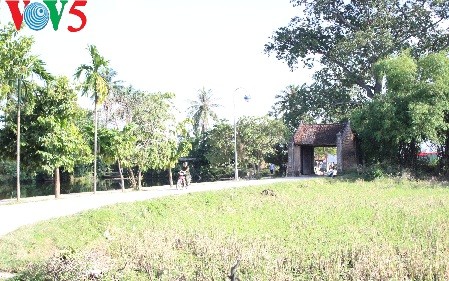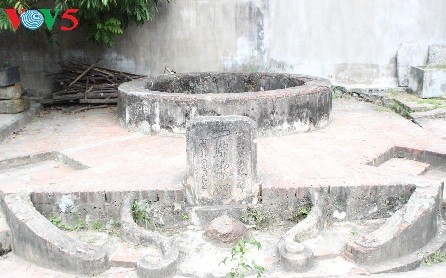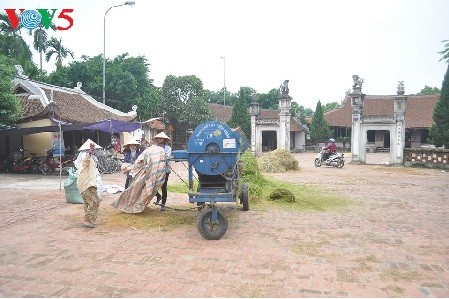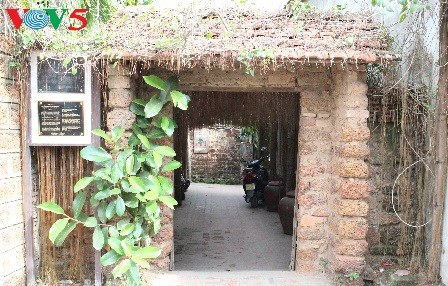(VOVworld) – Duong Lam ancient village in Son Tay Town lies 30 kilometers west of Hanoi along the Red River. The laterite village is famous as the cradle of the Red River Delta civilization and the home of two Vietnamese kings.
 |
| Duong Lam village’s gate. (Photo: Lan Anh/VOV5) |
Duong Lam still retains most of the characteristics of a typical Vietnamese village: a village gate, banyan trees, a wharf, a communal yard, pagodas, temples, a well, and rice fields.
It is just a short drive from the noisy city to the peaceful village of Duong Lam. Most of the construction there, including the village well, gates, communal house, and pagoda, are built of laterite and wood.
 |
| The ancient well in Duong Lam village (Photo: Lan Anh/VOV5) |
The most ancient features of Duong Lam village are its gates and the Mong Phu communal house. The village gate is built of laterite and has a curved arch. Duong Lam once had five gates, a main gate and four secondary gates facing four directions. The sole remaining gate was built in 1833. A sentence carved on top states that in any dynasty there is talent in the village.
Duong Lam’s gate stands beside a banyan tree, a lotus pond, and several rice fields. The beauty of the village and its gate has provided a marvelous wealth of inspiration for artists and photographers.
Nguyen Chinh, a Duong Lam photographer, told us: “Despite ups and downs, I still feel the integrity of Duong Lam village. The integrity originated from rural people who have long done wet rice farming in the Red River Delta.”
 |
| Mong Phu communal house (Photo: Lan Anh/VOV5) |
The Mong Phu communal house was built on the highest point of land at the center of Duong Lam village in 1684 in the reign of King Le Hy Tong. The architecture of the communal house is typical of the ancient Viet people. A wooden floor raised a certain distance above the ground, simulates the architecture of a stilt house.
The courtyard is lower than the surrounding foundation. When it rains, water runs out of the yard through sidewalk sluices. Inside are many antiques which have been preserved by generation after generation.
Duong Lam village is famous for temples and shrines worshipping royal personages. Duong Lam villagers are proud that this is the birthplace of King Ngo Quyen and King Phung Hung.
The temple dedicated to King Ngo Quyen was most recently renovated during the reign of King Tu Duc from 1848 to 1883. King Ngo Quyen is famous for the battle on Bach Dang River against China’s Southern Han troops. The historic battle ended 1,000 years of Chinese feudal rule and established the Ngo Dynasty, giving the Vietnamese people a new spirit of self-reliance and independence.
The temple worshipping King Phung Hung was built in Cam Lam commune where he recruited troops and rose up in arms in 791 to combat the domination of China’s Tang.
Phung Khac Thanh of Cam Lam commune says: “King Phung Hung summoned troops here for training and began the uprising. After he died, the villagers built a temple right here. The temple’s precinct used to be very large with lines of big pillars. But during the resistance war against the French colonialists, the locals implemented a scorched-earth policy and the temple was damaged. It was later re-built.”
 |
| The road leading to an ancient house in Duong Lam village. (Photo: Lan Anh/VOV5) |
Another highlight of Duong Lam is ancient houses. There are 956 ancient houses mainly in Dong Sang, Mong Phu, and Cam Thinh commune. Many of the houses were built in the 17th and 18th century, primarily of jackfruit wood and ironwood with sophisticated motifs on the doors.
Kieu Van Thong of hamlet 3, Dong Sang commune, says: “My house with 5 compartments and two sheds is made of wood on a laterite foundation. The central compartment is for worshipping, decorated with a curved arch gate and a platform made of sindora wood. The carvings illustrate tales. There is still an ancient laterite well in the courtyard. We know that these are what our ancestors handed down and need to be preserved.”
In 2006 Duong Lam became the first ancient village recognized as a National Cultural Historical Heritage.